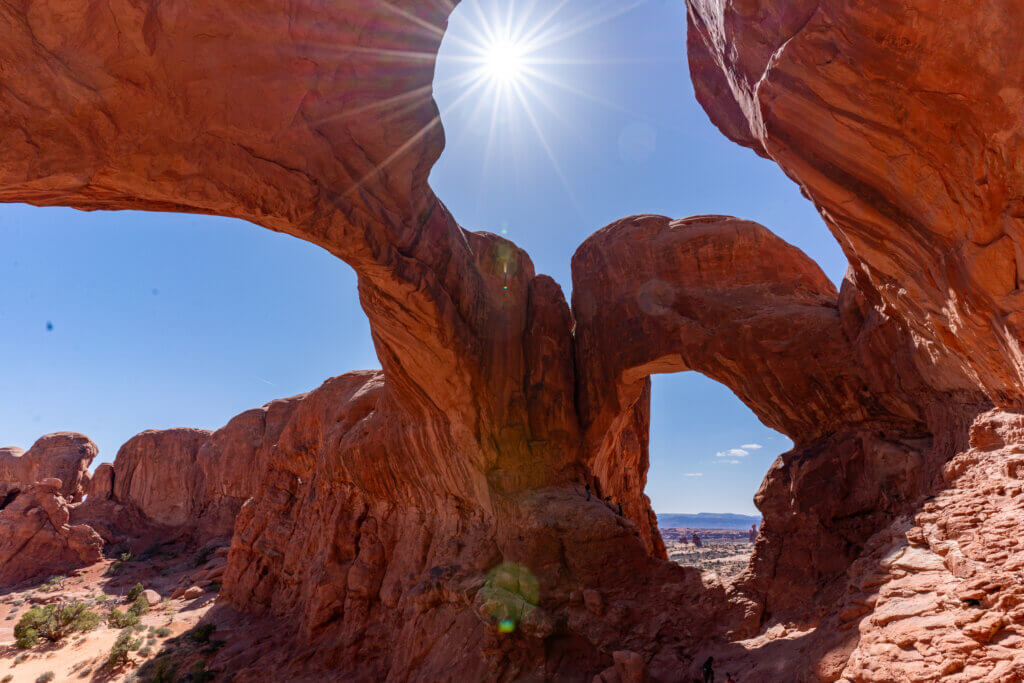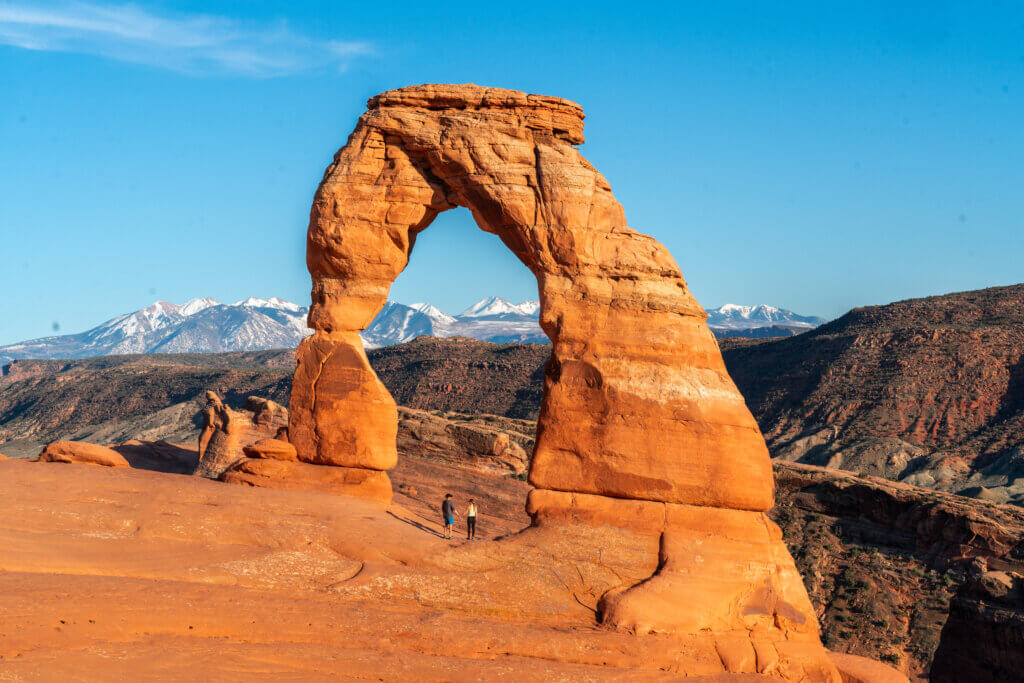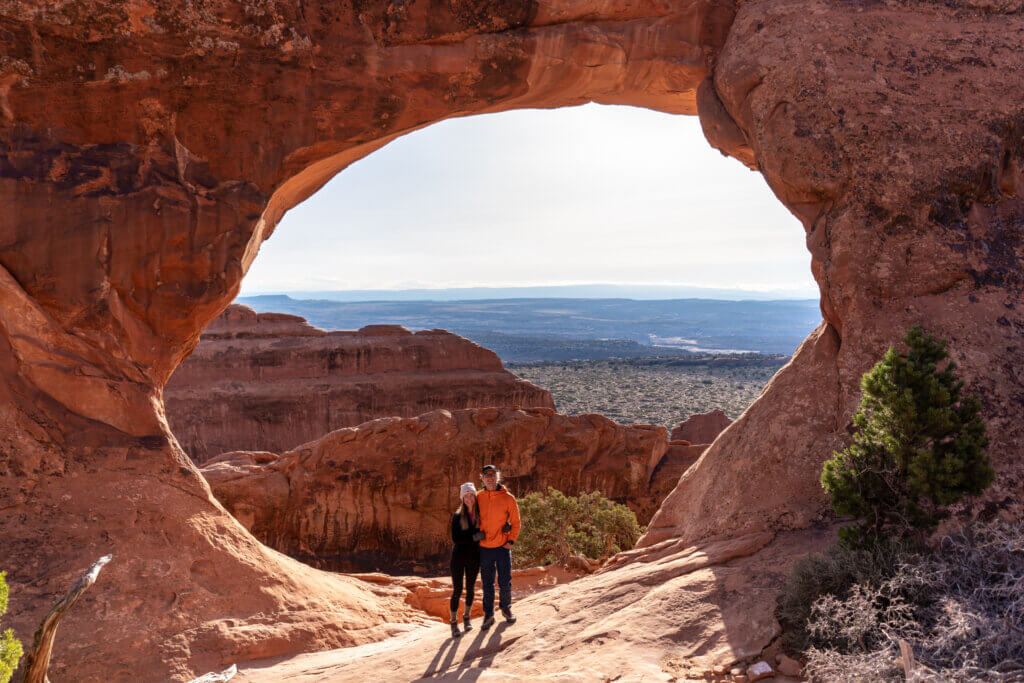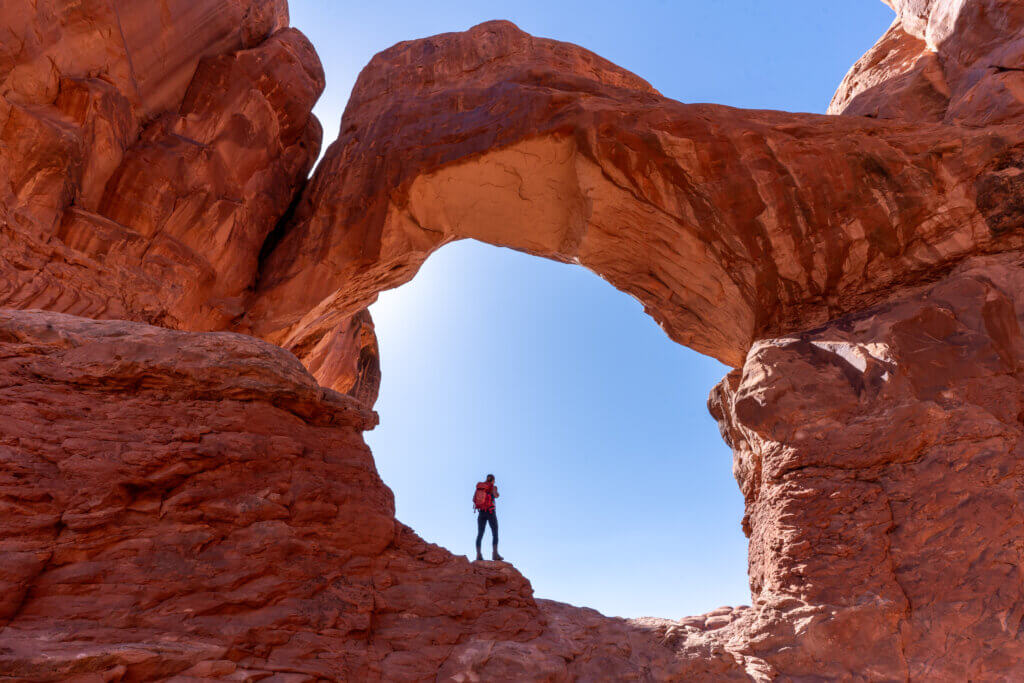Arches National Park is a mesmerizing wonderland of red rock arches, soaring fins, and breathtaking desert landscapes. Located in the heart of the Southwest, Arches is a playground for adventurers, nature enthusiasts, and anyone seeking an escape into the stunning beauty of the Utah desert. With over 2,000 natural stone arches, ancient rock formations, and awe-inspiring vistas, the park offers a sensory feast that will leave you in awe the entire time.
In this travel guide, we go over everything you need to know to explore Arches National Park! From the iconic Delicate Arch to the labyrinthine Fiery Furnace, we’ll give tips for visiting the park’s most celebrated landmarks and off-the-beaten-path gems. Whether you’re a seasoned hiker, a photography enthusiast, or a family looking for an unforgettable vacation, Arches has something to offer everyone.
Contents
| ***Disclosure: This post contains affiliate links. If you click one of them, I may receive a small commission (for which I am very grateful for) at no extra cost to you. |
When to Visit Arches National Park
Arches is a year-round destination park! Each season brings a unique experience and has its own advantages + disadvantages. Keep in mind that the weather in the desert can be unpredictable, so always check the weather forecast before your visit and dress accordingly. Also, if you plan to visit during peak seasons (Spring and Summer), be prepared for larger crowds and limited availability at the park’s campgrounds.
Spring, March-May
Spring is a GREAT time to visit Arches as the weather is mild, and the wildflowers are in bloom. The temperatures are comfortable for hiking, and you avoid the extreme heat of the summer months. Keep in mind that spring break and Easter holidays may bring increased crowds, and plan accordingly for those “peak” times.
Summer, June-August
Summer is the peak tourist season in Arches National Park. The days are long, and the park offers extended hours for visitors. However, temperatures can be scorching during the day, exceeding 100°F (38°C) and you are required to have timed-entry permit (info in section below). I personally do NOT recommend visiting in summer, as the crowds and heat make for a not so pleasant environment.
Fall, September-November
Fall is another excellent time to visit Arches. Like Spring, the weather is pleasant, and the park’s iconic landmarks are often less crowded compared to the summer months. The fall foliage add vibrant colors to the landscape, especially in late October.
Winter, December-February
Winter is the least crowded season at Arches National Park, making it a nice choice if you’re seeking solitude. The temperatures can be cold, especially at night, and snow is possible. However, daytime temperatures are usually comfortable for hiking.
Arches National Park Timed-Entry
Arches National Park has implemented a timed entry system to manage visitation and reduce congestion during peak season. A Timed-Entry permit is required to enter the park from April 1-October 31 each year during the hours of 7 am-4 pm.
Here are a few things you’ll need to know about the timed entry permitting system:
- To enter the park during the timed-entry period, you must make a reservation in advance through Recreation.gov. The reservation includes a specific date and entry time, and you are required to arrive within the designated timeframe.
- Timed entry tickets are required in addition to your park pass and/or entrance fee. The timed-entry ticket is free but recreation.gov charges a $2 processing fee for each reservation.
- The park releases the tickets 3 months in advance on a first-come, first-served bases, BUT a limited number of tickets will be released at 6 pm the day prior to entry. THESE GO FAST… make sure you are logged in exactly at 6 pm and know the time you are looking to book!
- Once in the park, you’re free to stay for as long as you like! The timed entry has no specific “exit” time.
How to Get to Arches National Park
Arches is in southeastern Utah, near the town of Moab. Most people fly into one of the surrounding airports and then rent a car to drive the rest of the way. The closest airport to Arches National Park is in Grand Junction, CO which is about 110 miles away. If you are planning on visiting more than just Arches during your time in Utah, then you may want to consider flying into Salt Lake City (235 mi away) or Las Vegas (453 mi) and road tripping your way over!
If you’re planning a Utah road trip, be sure to check out our epic 2-week itinerary!
Where to Stay in/near Arches National Park
There are 2 campgrounds located in Arches National Park, Devils Garden Campground and Willow Flat Campground. Both campgrounds are super popular and book out months in advance. You can book these on recreation.gov.
Arches itself does not have any hotel or lodge options within the park, but there are several options available in and near the town of Moab, which is located just outside the park’s entrance. Moab has a wide array of lodging options including hotels, air bnb’s, campgrounds, rv parks, dispersed camping, ect… and the town is super cute!
Regardless of where you choose to stay, you’ll need to book your accommodation in advance, especially during the peak season (spring and summer). Moab is a popular destination, not only for Arches National Park but also for Canyonlands National Park and Dead Horse Point State Park. It’s imperative that you book in advance!
How Many Days Do You Need to Explore Arches National Park
IT DEPENDS (ah, such a classic answer) … How many days you should set aside to explore Arches really depends on your interests, fitness level, and how much you want to see and experience. While 1 day is enough to see the highlights, it won’t allow you to venture on some of the longer activities like hiking Devil’s Garden or exploring Fiery Furnace. I would suggest spending 2-3 days in Arches if you’re someone who likes to get out on the trails to explore!
Must-Do Hikes in Arches!
Speaking of trails… Arches is the perfect park for “little effort, big reward” when it comes to hiking. A lot of the best trails are short and sweet and lead to some of the park’s most iconic Arches! These are some of our favorites-
Windows & Turret Arch
-1.2 mi loop
-150 ft elevation gain
The Windows and Turret Arch hike in Arches National Park is super popular and relatively easy trail that leads to three impressive arch formations, North Window, South Window, and Turret Arch.
The trail starts with a flat, sandy path that leads to the North Window and South Window arches. After visiting the Windows, follow the marked trail to Turret Arch, which is located a short distance away. Turret Arch is smaller than the Windows but equally captivating, with its unique shape and position between two massive sandstone fins. Beyond Turret Arch, the trail continues as a loop, taking you around the backside of the Windows. Taking the full loop gives you a different perspective of the arches and additional views of the surrounding rock formations.
Double Arch
-0.6 mi out & back
-100 ft elevation gain

The Double Arch trailhead is located right beside the Windows hike Trailhead and is more of a walk rather than a hike. The path is mostly flat and easy to navigate, making it suitable all ages and fitness levels! Double Arch is unique in the fact that it was formed by downward water erosion from atop the sandstone, rather than from side-to-side water erosion like most of the other arches in the park. It is one of our favorite Arch formations in the park and one not to be missed!
Balanced Rock Loop
-0.3 mi loop
-50 ft elevation gain
The highlight of the Balanced Rock Loop Trail is the Balanced Rock itself—a massive sandstone boulder precariously perched on a tall pedestal. The rock appears perfectly balanced yet looks like it could fall at ANY moment!
Delicate Arch
-3.2 mi out & back
-650 ft elevation gain

Delicate Arch is arguably the most iconic landmark in Arches National Park. It is a massive freestanding natural arch, perched on the edge of a slickrock bowl, with mountains for as far as you can see in the distance!! Of course, because of its popularity it is ALWAYS crowded… sunrise, sunset, mid-day… crowded. There is a large viewing area with room for many, so be prepared to share the beloved Arch with others. It is still 100% worth going to see though!
Landscape Arch
-1.9 mi out & back
-250 ft elevation gain

Landscape Arch is known for being the longest Arch in North America! The thin and delicate rock formation was named so due to its “landscape-like” appearance. To get to Landscape Arch you will take the Devil’s Garden Trail, which will lead you to a designated viewing area where you can admire the Arch from a safe distance. Due to its delicate nature, access to the area under the arch is restricted to preserve its structural integrity.
Devil’s Garden Primitive Loop
-8.0 mi loop
-1,150 ft elevation gain

I cannot recommend the Devil’s Garden Primitive Loop enough!! The loop takes you to 8 different arches, each being super unique! The loop is rarely travelled, which is nice compared to the bustling trails of the rest of the park. The Devil’s Garden Loop is one of the only places in the entire park where we felt we were able to get some solitude… and it was so lovely!
Fun Experiences in Arches National Park
I always recommend getting out on the trails when exploring National Parks, BUT there are always alternative and unique ways to see each park that doesn’t involve hiking!
Fiery Furnace
The Fiery Furnace is a unique area within Arches. It is a natural maze of narrow canyons, towering sandstone fins, and arches that you hike/crawl/scramble through. The Fiery Furnace can be accessed by booking a ranger-led tour or by booking self-exploration permits, both of which are highly competitive to get! You can book the tour/permits up to 7 days in advance at recreation.gov.
I recommended that you book the ranger led tour for your first time visiting, as it is VERY easy to get lost within the Fiery Furnace.
Arches Scenic Drive
The Arches Scenic Drive is a 36-mile (58-kilometer) round-trip paved road that begins at the park’s entrance and takes you on a journey through some of the most iconic and accessible areas of Arches National Park. The drive starts at the Arches Visitor Center, where you can obtain a map and information about the park.
Along the drive, you’ll be treated to breathtaking panoramic views of the park’s red rock formations, mesas, and canyons. There are tons of designated pullouts and viewpoints along the way, and several of the park’s famous Arches are right on the side of the road!
Catch a Sunrise/Sunset

As always, you should strive to be up before the sun or stay until the sun fades away to experience some of the park’s most breathtaking views during golden hour! PLUS this is your best crowd beater AND you won’t require a permit to enter during these times. Win-win-win!
Stargaze

Arches National Park is designated as an International Dark Sky Park, which means that it is recognized for its efforts to preserve and protect natural darkness. The light pollution is minimal which allows for clearer and more vibrant views of the night sky, making it a PRIME stargazing destination!
Travel Tips
- Guide along: We recommend this for every single national park! Guide along is a location-based audio tour that gives you tips and stories about the location your driving along. The tour operates totally offline and hands free! Check it out here!
- Go see the touristy sights: they are touristy for a reason! It may be crowded, but if it’s your first time to Arches, you’ve got to do it.
- SUNRISE will be your crowd beater: The earlier you arrive, the less people you will be sharing the view with. Pick your poison: sleep and crowds or no sleep and less people
- Make sure you have sturdy hiking boots and a good day pack! We love these men’s and women’s Solomons for boots, and we both have this Ortovox day pack.
- Always carry sunscreen and a hat! The desert sun is unrelenting… no matter what season it is.






